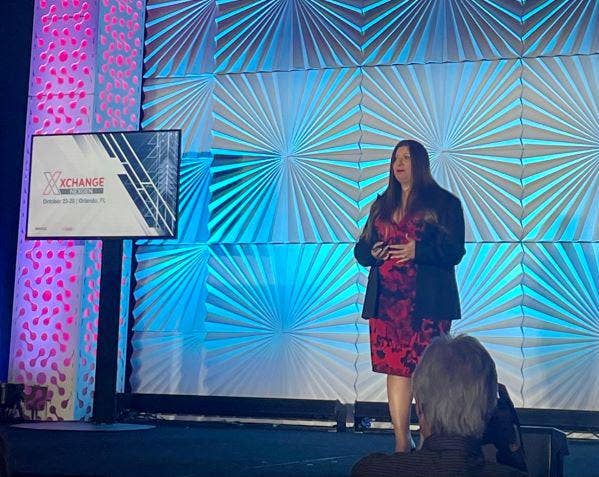5 Tips For MSPs Zeroing In On SMBs
75 percent of SMBs are eager to invest in new technology, representing a massive area of opportunity for MSPs targeting SMBs, according to Cisco’s Michelle Ragusa-McBain.

Eye On The SMB Prize
The small and midsize business, or SMB segment, is made up of 400 million companies around the world and accounts for 65 percent of global employment. It also represents a $610 billion IT spend, representing a massive opportunity for the channel, according to Michelle Ragusa-McBain, Cisco Systems’ provider elevate leader.
The COVID-19 pandemic sped along IT trends that were already creeping in the background, including the as-a-service trend, especially in the SMB space. Today, a third of Cisco’s revenue is being driven by subscriptions, and they aren’t the only ones. Tech giants such as HPE, Dell and IBM are also going all-in on subscriptions and consumption-based IT.
“You can see the writing on the wall of how things are converting and changing,” Ragusa-McBain told an audience of solution providers at CRN parent The Channel Company’s XChange NexGen 2022 conference in Orlando, Florida on Tuesday.
Ragusa-McBain during her keynote shared research from Cisco and other third-party research firms that illustrate the changing IT landscape and demand for different buying models coming from SMBs. She also shared five tips that MSPs can implement to boost their marketing strategies and content distribution and how to craft the right portfolio of technology solutions to grow their businesses despite, or perhaps because of, the “new normal.”
Here’s what Ragusa-McBain told partners.

Find Blue Ocean Opportunities
According to recent research from Cisco, 75 percent of SMBs are eager to invest in new technology, which should be music to the ears of their trusted IT partners. Regardless of what these businesses specialize in, every business became a tech company during the pandemic and that’s a trend that isn’t turning around, Ragusa-McBain said.
SMBs are leaning into hybrid work know that they need new solutions in place to help them transform their businesses. But there’s a disconnect -- about 83 percent of these companies don’t have a person or IT team to lead the charge.
“This spells opportunity for everybody in the room,” Ragusa-McBain said.

The Perfect Storm
It was always an unspoken requirement for SMBs to be agile in the face of change and when compared to their enterprise counterparts, these businesses have historically had a reputation for being more nimble than larger companies. However, the COVID-19 pandemic accelerated the pace of change.
In fact, 75 percent of CEOs say that their business unrecognizable in five years, a stat that probably doesn’t surprise many channel partners, Ragusa-McBain said. Research firm McKinsey found that in 2020, companies spent the most money on digitalization. At the same time, the tech industry saw a shift in buying behaviors in favor of financial models such as everything as a service and managed services.
That means that networking and building the right relationships matter for MSPs, Ragusa-McBain said. It could mean publicizing your “niche” or thought leadership on LinkedIn.
“What are some of the verticals who you represent? If you have a niche, you can be the trusted expert in your niche. ‘I am a trusted expert for midsized clinics in upstate New York,’ you can be that specific, she said.

The Future of Work
Ragusa-McBain said that 85 percent of decision makers choose to absorb up to five pieces of content before they even talk to a salesperson. That content includes everything from white papers, webinars, third-party analyst reports, blogs, videos, customer testimonials and infographics. That means that customers are perhaps more empowered than ever before to make buying decisions.
“How many of you are producing that content in your business today? All of it? some of it? none of it? There’s an opportunity.” she told partners.
Clutch Solutions LLC is a Gilbert, Arizona-based VAR that is partnering with MSPs to meet its customer demand for managed services. In the beginning of the pandemic, the firm saw high demand for new hardware to enable employees to work from home. That demand has since been replaced with security-related projects, said Scott Gossett, president of Clutch Solutions. Still, customers are taking their time in making IT buying decisions and they are very well-educated, often having done their own research before coming to Clutch, Gossett said.
“I think the economy is really making a lot of our customers say, well, let’s wait a quarter, let’s see what’s going on before we take the plunge and commit to something. They’re also very knowledgeable, so it makes us sharper because we need to make sure that we’re providing the right solutions for those customers,” he said.

Double Down On Security
One cyberattack happens about every 39 seconds, according to Cisco. Trends that emerged during the pandemic, such as working from home or working remotely, did exacerbate security issues. Like it or not, security is and will always been a huge area that customers need help with and need their partners to address, said Ragusa-McBain.
“Bad actors are not getting better. They’re just getting more creative with what the times are, and the changes are,” she said. “Cybersecurity attacks would cost the world in excess of $10.5 trillion with a T dollars annually, starting in 2025.”
Partners need to be “hyperactive” when it comes to security, but only about 50 percent of partners have cyber insurance right now, Ragusa-McBain warned.

The Power Of Community
No matter what trends are gripping the IT industry, some old attitudes still remain true. People buy from people they like, Ragusa-McBain said.
It’s a sentiment that Clutch Solutions’ Gossett lives by.
“With us, it’s all about relationships. We need to be valuable those customers and they come to us to be that one stop shop to be that trusted advisor, bringing in our engineering team to help bring those solutions,” he said. “So, once you build that trusted advisor role, they’ll let you in the door and they’ll there’ll be more open to things that they’re not aware of, or they don’t see how it fits their technology … they’ll be more open to a demo or proof of concept.”